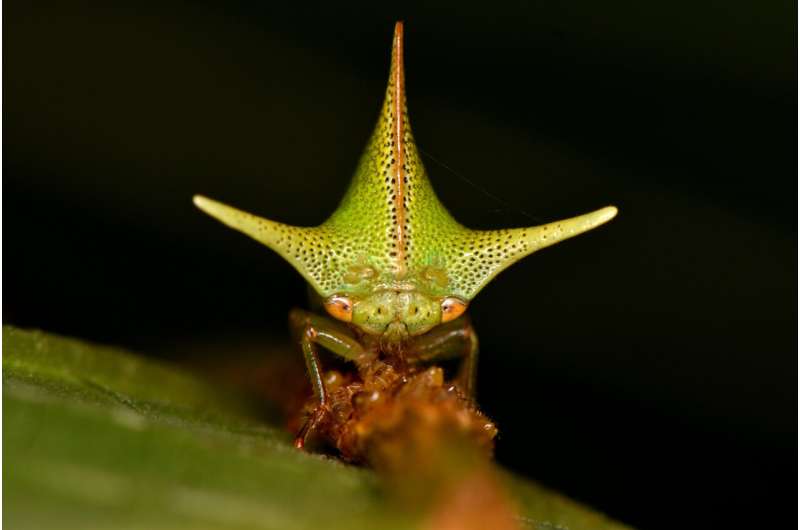Science
Treehopper Evolution Tied to Static Electricity Discovery

A recent study suggests that the extreme body shapes of treehopper insects may have evolved as a response to their ability to detect static electricity. This hypothesis was presented by Dr. Sam England and Professor Daniel Robert from the University of Bristol in a paper published on August 2, 2025, in the prestigious journal Proceedings of the National Academy of Sciences.
Treehoppers, which include over 3,000 species, are renowned for their remarkable morphological diversity. Their shapes range from horns and spines to more elaborate forms like balls and tridents. Despite their unusual appearances, scientists have struggled to find a definitive explanation for the function of these varied shapes. While some theories suggest purposes such as camouflage or defense, they do not apply universally across the entire treehopper family.
In their research, Dr. England and Professor Robert explored the possibility that these unique body forms assist treehoppers in detecting static electricity, similar to other insects like bees and caterpillars. They observed that predatory wasps emit static electricity and noted that treehoppers tend to retreat from electric fields. This led the researchers to investigate whether the morphology of treehoppers could enhance their sensitivity to such electric fields.
The study utilized computational methods to demonstrate that the extreme shapes of treehoppers could amplify the electric field strength around them. This adaptation likely increases their ability to sense static electricity. Additionally, the researchers discovered significant differences in the electrostatic charges of predatory wasps compared to the stingless bees that often provide protection to treehoppers. This finding suggests that treehoppers may be capable of distinguishing between threats and allies based solely on electrical signals.
Dr. England remarked, “We think our study provides a really exciting launch pad for investigating static electricity as a driver of organismal morphology more generally.” He emphasized that while their findings offer the first evidence linking electrostatic sensitivity to morphological evolution, further research is necessary to confirm this connection.
Looking ahead, the research team plans to examine how different treehopper body shapes might adapt to various electrical environments. Dr. England noted, “If we can link treehopper shapes to certain aspects of their electrical ecology, like specific predators which approach from certain angles with particular static charges, this would really begin to strongly support our ideas around static electricity as an evolutionary driver.”
The implications of this research extend beyond treehoppers. The study highlights the potential role of static electricity in the evolution of other organisms with extreme body shapes, including various insects and plants. As scientists continue to explore the relationship between morphology and electroreception, the findings could reshape our understanding of evolutionary biology.
For those interested in the detailed findings, the full study is available in the Proceedings of the National Academy of Sciences, DOI: 10.1073/pnas.2505253122.
-

 Entertainment2 weeks ago
Entertainment2 weeks agoLove Island Star Toni Laite’s Mother Expresses Disappointment Over Coupling Decision
-

 Entertainment2 weeks ago
Entertainment2 weeks agoWoman Transforms Life with Boot Camp, Losing Nearly 9 Pounds in a Week
-

 Lifestyle3 weeks ago
Lifestyle3 weeks agoBring Birds to Events and Dine with Style: Trends This Week
-

 World3 weeks ago
World3 weeks agoCoronation Street Recasts Lily Platt Amid Dramatic Storyline
-

 Entertainment1 week ago
Entertainment1 week agoMary Goskirk’s Injury Raises Questions in Emmerdale Episode
-

 Sports3 weeks ago
Sports3 weeks agoGAA Faces Controversial Decision on DJ Carey Before Final
-

 Entertainment3 weeks ago
Entertainment3 weeks agoBob Vylan Drops Out of European Tour with Gogol Bordello After Controversy
-

 Lifestyle3 weeks ago
Lifestyle3 weeks agoAylesbury Committee Approves Controversial 24-Hour McDonald’s
-

 Entertainment3 weeks ago
Entertainment3 weeks agoJessica Alba’s New Relationship Unveiled with Younger Actor
-

 Science3 weeks ago
Science3 weeks agoAstronomers Discover Giant Exoplanet in Star’s Dusty Surroundings
-

 Entertainment3 weeks ago
Entertainment3 weeks agoKeeley Hawes Takes Risks in High-Octane New Series The Assassin
-

 World3 weeks ago
World3 weeks agoBritish Man, 26, in Critical Condition After 22ft Fall in Ibiza








